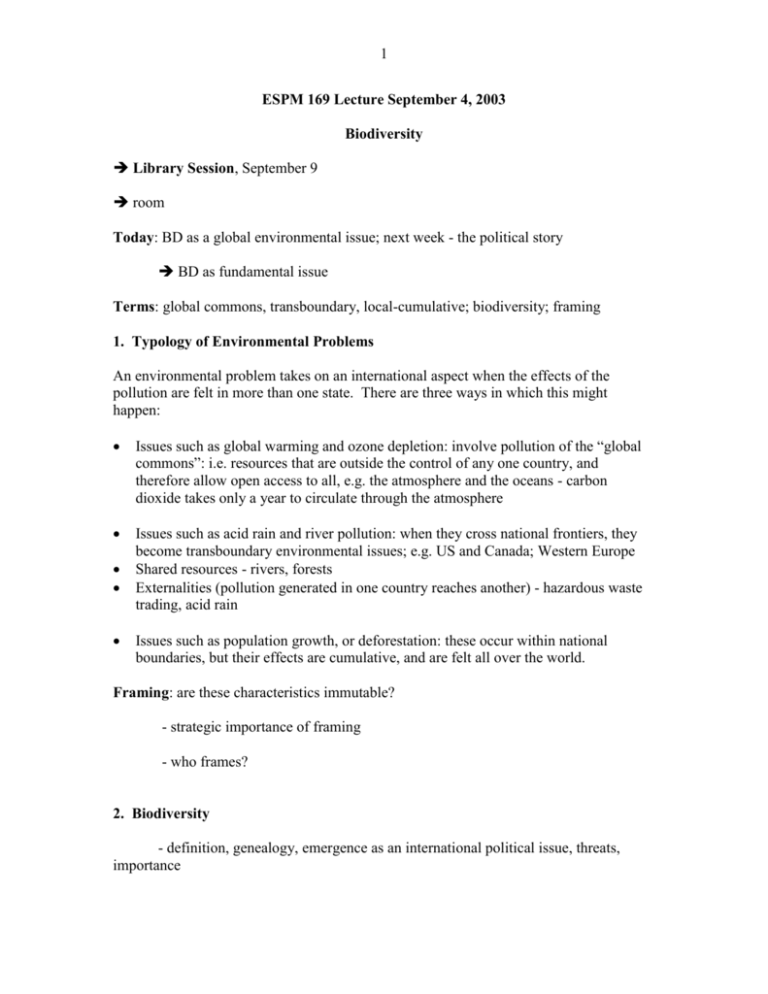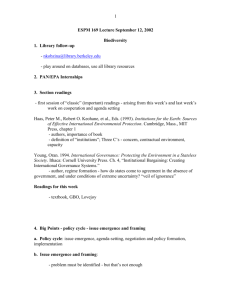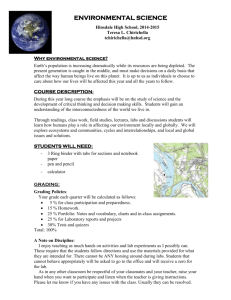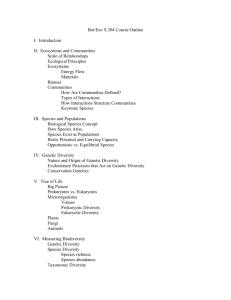week2.2.biodiversity - College of Natural Resources
advertisement

1 ESPM 169 Lecture September 4, 2003 Biodiversity Library Session, September 9 room Today: BD as a global environmental issue; next week - the political story BD as fundamental issue Terms: global commons, transboundary, local-cumulative; biodiversity; framing 1. Typology of Environmental Problems An environmental problem takes on an international aspect when the effects of the pollution are felt in more than one state. There are three ways in which this might happen: Issues such as global warming and ozone depletion: involve pollution of the “global commons”: i.e. resources that are outside the control of any one country, and therefore allow open access to all, e.g. the atmosphere and the oceans - carbon dioxide takes only a year to circulate through the atmosphere Issues such as acid rain and river pollution: when they cross national frontiers, they become transboundary environmental issues; e.g. US and Canada; Western Europe Shared resources - rivers, forests Externalities (pollution generated in one country reaches another) - hazardous waste trading, acid rain Issues such as population growth, or deforestation: these occur within national boundaries, but their effects are cumulative, and are felt all over the world. Framing: are these characteristics immutable? - strategic importance of framing - who frames? 2. Biodiversity - definition, genealogy, emergence as an international political issue, threats, importance 2 a. Definitions Write down important elements of biodiversity Convention Definition: “all aspects of variability evident within the living world, including diversity within and between individuals, populations, species, communities and ecosystems….the term is commonly used loosely to refer to all species and habitats in some given area or the earth overall” “Biological diversity incorporates the idea of distinctiveness at every level of life from molecules to cells, to individuals, to species, to assemblages of species and to ecosystems” (Murray, 1995:19) b. Genealogy of Term conservation to biological diversity to biodiversity - important part of framing process importance of conservation biology community c. Levels of BD: 1. Genetic - most basic building-block of BD: blueprint for individual organisms 2. Species (most useful measure) - distinctive groups of similar populations that are isolated reproductively from other such groups 3. Ecosystems 4. All add up to the biosphere - through which BD is distributed - hot-spots; tropics - also a framing issue for international action Genetic BD: important because genetic diversity ensures survival in changing conditions - wild genes in grain production - loss of genetic diversity in threatened populations - biotechnology first point of serious controversy in case 3 we have always manipulated genetic diversity, but at an organism level - interbreeding animal species and plant species. In the 1990s, techniques have emerged to engineer genes themselves - producing GMOs - using genes from entirely different organisms strong arguments as to whether it will destroy BD or save us Species BD: historically, the main framing of the problem - easy to measure, map and demonstrate - 1.75 million plant and animal species have been identified; possibly many millions more - extinction: does occur naturally, but rate has been much higher; around 300-350 species of vertebrates, 400 invertebrates in the last 400 years; higher number of plant species. - threatened species: 24% of mammal species and 12% of birds considered threatened with extinction in 2000. Ecosystems (Habitats): - marine and coastal - freshwater - forests - dry and sub-humid land ecosystems - agricultural ecosystems d. Value of BD again, an important part of the framing process a basic issue: underlies the continuation of life on earth - see Lovejoy piece - aesthetic and ethical: charismatic macrofauna; ethical responsibility to protect BD - economic - food, medicine are most commonly cited - agriculture, water, fish - most important source of protein for a lot of the world; water a source of energy, too. - tourism - ecological - natural services - cleansing (dispersal and breakdown of wastes), climate regulation, protection from erosion, pollination - especially bacteria, and other lower forms of life 4 e. Threats to BD write down threats! - proximate and fundamental (fixed and malleable - stuff we can do something about, stuff we can't) - anthropogenic threats - again, framing - habitat conversion, fragmentation, destruction (desertification, salinization) - in particular, forest loss, development of wetlands and swamps - 1980: 113,000 km2 of tropical forest was cleared, up to 169,000 in 1990 - invasive, introduced species (rabbits in Australia as eg of both!) - climate change - chemical pollution - waste, acid rain, oil spills - nitrogen deposition from fertilizers, fossil fuel burning (algae blooms) - population growth - consumption indicators of threats: loss of genetic diversity in agriculture (loss of useful pests and insects); loss of species; degradation of hotspots; endangered species - see Global BD Outlook f. Why is International Action important? - monitoring and cataloging - system-level effects - global dependence on resources in different parts of the world - “stewardship” arguments - shared problems - transboundary crises - e.g. Lake Victoria (Kenya, Tanzania, Uganda) - links with climate change g. Getting back to typology where does BD fit in? - in some sense, a "global commons" issue; in others, a local cumulative issue also transboundary therefore, importance of framing








